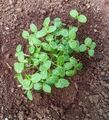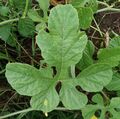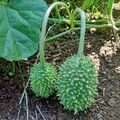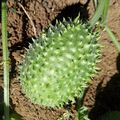Biology:Cucumis anguria
| Cucumis anguria | |
|---|---|
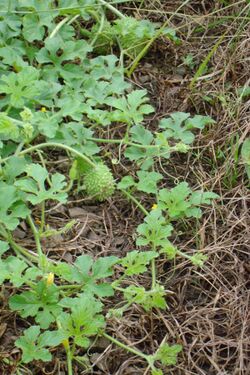
| |
| Scientific classification | |
| Kingdom: | Plantae |
| Clade: | Tracheophytes |
| Clade: | Angiosperms |
| Clade: | Eudicots |
| Clade: | Rosids |
| Order: | Cucurbitales |
| Family: | Cucurbitaceae |
| Genus: | Cucumis |
| Species: | C. anguria
|
| Binomial name | |
| Cucumis anguria | |
| Varieties[2] | |
| |
| Synonyms[2] | |
| |
Cucumis anguria, commonly known as maroon cucumber,[3] West Indian gherkin,[4] maxixe,[5] burr gherkin,[6] cackrey,[7] and West Indian gourd,[3] is a vine that is indigenous to Africa, but has become naturalized in the New World, and is cultivated in many places.[2] It is similar and related to the common cucumber (C. sativus) and its cultivars are known as gherkins.[citation needed]
Description
Cucumis anguria is a thinly stemmed, herbaceous vine scrambling up to 3 meters long. Fruits (4–5 cm × 3–4 cm) grow on long stalks, and are ovoid to oblong. The fruits are covered with long hairs over a surface of spines or wart-like bumps. The inner flesh is pallid to green.[3]
Distribution
Although naturalized in many parts of the New World, Cucumis anguria is indigenous only to Africa, in the following countries: Angola; Botswana; the Democratic Republic of the Congo; Malawi; Mozambique; Namibia; South Africa (KwaZulu-Natal, Limpopo, Mpumalanga); Eswatini; Tanzania; Zambia; and Zimbabwe.[2]
Cucumis anguria has become naturalized in: Anguilla; Antigua and Barbuda; Australia (Queensland and Western Australia[8]); Barbados; Brazil ; Cayman Islands; Costa Rica; Cuba; the Dominican Republic; Ecuador; French Guiana; Grenada; Guadeloupe; Guatemala; Haiti; Honduras; Jamaica; Madagascar ; Martinique; Mexico; Netherlands Antilles; Nicaragua; Panama; Peru; Puerto Rico; Saint Lucia; Saint Vincent and Grenadines; Suriname; the United States (California , Florida, Georgia, Massachusetts , Montana, New York, Oregon, Texas , Minnesota, Wisconsin and Washington (state) ); Canada (Ontario, Niagara Region); Venezuela; and both British and American Virgin Islands.[2][4]
Cucumis anguria is also cultivated, but not indigenous to, nor yet believed to have become naturalized in these places: Cape Verde; Réunion; Senegal; and parts of the Caribbean not already mentioned above.[2]
Uses
Cucumis anguria is primarily grown (as a crop plant) for its edible fruit, which are used in pickling, as cooked vegetables,[3][9] or eaten raw.[3] The flavor is similar to that of the common cucumber.[10] C. anguria fruits are popular in the northeast and north of Brazil , where they are an ingredient in the local version of cozido (meat-and-vegetable stew).[citation needed]
Cucumis anguria has been used in folk medicine to treat ailments of the stomach.[11]
Pests
Crops are susceptible to attacks by fungi, aphids, and cucumber beetles.[3]
Synonyms
This species, Cucumis anguria L., has a name that other species may share:
- Cucumis anguria Forssk., a synonym for Cucumis prophetarum
Gallery
-
Seedlings
-
Plant
-
Leaf
-
Flower
-
Fruits
-
Inside the fruit
References
- ↑ Cucumis anguria was originally described and published in Species Plantarum 2: 1011. 1753. "Name - !Cucumis anguria L.". Tropicos. Saint Louis, Missouri: Missouri Botanical Garden. http://www.tropicos.org/Name/9200598. Retrieved November 4, 2012.
- ↑ 2.0 2.1 2.2 2.3 2.4 2.5 {{citation | mode = cs1 | title = Cucumis anguria | work = Germplasm Resources Information Network (GRIN) | url = | publisher = [[Organization:Agricultural Research ServAgricultural Research Service (ARS), United States Department of Agriculture (USDA) | access-date = November 4, 2012 }}
- ↑ 3.0 3.1 3.2 3.3 3.4 3.5 "Cucumis anguria". EcoCrop. FAO. 1993–2007. http://ecocrop.fao.org/ecocrop/srv/en/cropView?id=5008. Retrieved November 4, 2012.
- ↑ 4.0 4.1 "Profile for Cucumis anguria (West Indian gherkin)". PLANTS Database. USDA, NRCS. http://plants.usda.gov/java/profile?symbol=CUAN. Retrieved November 4, 2012.
- ↑ "Maxixe | WorldCrops". https://worldcrops.org/crops/maxixe.
- ↑ Weaver, William Woys. "Growing Burr Gherkins - Organic Gardening" (in en). https://www.motherearthnews.com/organic-gardening/growing-burr-gherkins-zmaz08djzgoe.
- ↑ "Cackery". http://ecocrop.fao.org/ecocrop/srv/en/cropView?id=5008.
- ↑ "Cucumis anguria". FloraBase. Western Australian Government Department of Parks and Wildlife. https://florabase.dpaw.wa.gov.au/browse/profile/17340.
- ↑ Purseglove, J.W. (1968). Tropical Crops Dicotyledons. London: Longmans, Green and Co. Ltd.
- ↑ "How to Grow Gherkins". 3 September 2013. http://gardeningjones.com/blog/2013/09/03/how-to-grow-gherkins/. Retrieved 26 July 2020.
- ↑ James A. Duke. "Cucumis anguria (CUCURBITACEAE)". Dr. Duke's Phytochemical and Ethnobotanical Databases. https://phytochem.nal.usda.gov/phytochem/ethnoPlants/show/9985. Retrieved December 25, 2017.
Wikidata ☰ Q2349096 entry
 |
